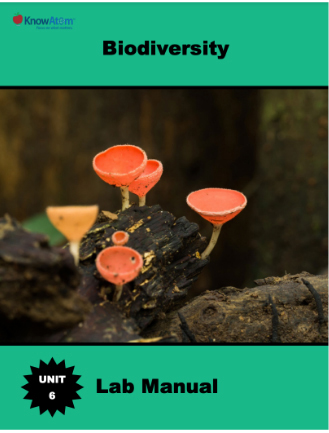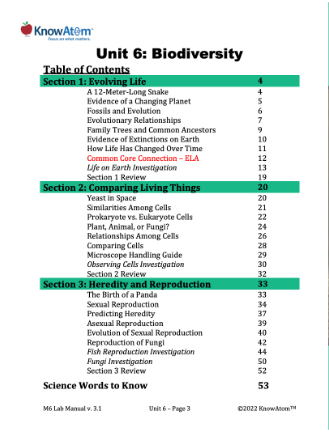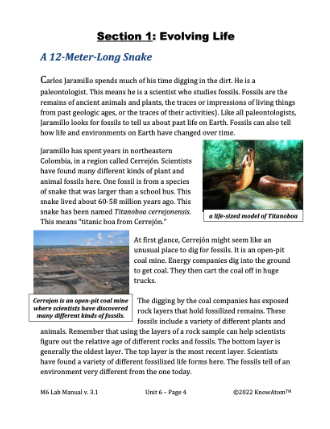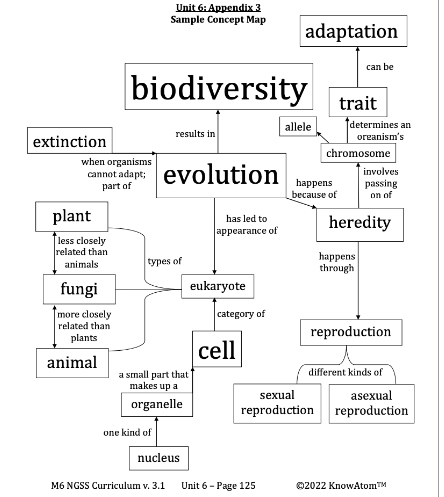In this lesson, students explore the phenomena of reproduction with a mushroom dissection, connecting the different structures of the fungi with its ability to reproduce.
In this unit, students explore how life has changed and become more diverse over time. In this lesson, students dissect fungi to figure out how they reproduce. This page highlights components of this lesson.
The science background section gives teachers more detailed information on the phenomena students explore in this unit. Here is an excerpt of the science background section from this lesson on the phenomena of reproduction and fungi structures.
For many years, scientists had a hypothesis about the evolutionary advantage of sexual reproduction. They thought that the genetic variation of sexual reproduction made species more able to adapt to changes in their environment. This would make them more likely to survive as a species. According to this hypothesis, if some individuals had traits that could help them survive in a changed environment, those individuals would be able to survive and reproduce even if other individuals couldn’t survive.
Scientists didn’t have evidence to support that hypothesis. In recent years, scientists have been conducting experiments to help them answer the question of why sexual reproduction is so useful.
One way to do this is to compare a species of organisms that can reproduce both sexually and asexually. For example, a group of scientists has studied a group of small fish called topminnows in Mexico. Some populations of topminnow reproduce asexually. Other populations of topminnow reproduce sexually.
The scientists knew that a parasitic worm was common in the topminnow population. The worm invaded some of the fish and harmed them, making it harder for them to reproduce. The scientists found that the population of topminnows that reproduced asexually had many more parasitic worms than the population of topminnows reproducing sexually.
These findings support the hypothesis that sexual reproduction gives organisms an evolutionary advantage. The genetic variation gives the sexually reproducing population a better chance of adapting to and surviving the parasitic worm. Studies of other species support these findings as well, but scientists are continuing to research their question.
When the mushroom is ready to reproduce, it releases its spores into the environment. Those spores that land in a good environment, such as soil or plant litter, will begin to develop into a new organism.
First, the spores begin to grow hyphae (threadlike structures that can fuse together into a network of tissues called mycelium). Once the network of mycelium grows large enough, it forms mushrooms. A mature mushroom can produce millions or billions of spores in a single day.
Most fungi reproduce asexually most of the time. This is because of the advantages to asexual reproduction: it is more efficient, taking less time and producing more offspring. In asexual reproduction, the spores hold a copy of the parent’s full set of genetic information.
However, sometimes fungi need to be able to adapt to a changed environment, and so they can also reproduce sexually. This usually happens when nutrients or water are scarce.
In this lesson, students explore the phenomena of reproduction with a mushroom dissection, connecting the different structures of the fungi with its ability to reproduce.

Prepared hands-on materials, full year grade-specific curriculum, and personalized live professional development designed to support mastery of current state science standards.
Allele : a form of the same gene that has small differences in the sequence of DNA bases
Asexual Reproduction : reproduction that requires only one parent (e.g., binary fission, budding, and fragmentation)
Chromosome : a threadlike structure of DNA and protein; found in the nucleus of eukaryotic cells; a discrete package of genetic material
Reproduction : the ability of a mature organism to have offspring
Sexual Reproduction : the creation of a new individual from combined genetic information of two parents of different sexes
Reproduction of Fungi
Many species of fungi can reproduce both asexually and sexually depending on the conditions of the environment. There are about 1.5 million species of fungi in the world. This includes baking yeast, the microscopic organisms known for causing athlete’s foot, and a 605-ton honey mushroom in Oregon.
We’ll focus here on those species of fungi that produce mushrooms. The mushrooms that most people are familiar with are fruiting bodies. This means that they produce spores. A spore is a seed-like cell that is released by mature mushrooms. It contains all of the material needed to grow into a new fungus.
First, the spores begin to grow hyphae. Hyphae are the threadlike structures that can fuse together into a network of tissues called mycelium. Once the network of mycelium grows large enough, it forms mushrooms. A mature mushroom can produce millions or billions of spores in a single day.
This process can be very complex depending on the species of fungi. Fungi don’t have male or female organisms. However, they are able to combine genetic information. This allows them to introduce genetic variation into the population.



For the hands-on activity of this lesson, students figure out the external structures of mushrooms they cultivate in the classroom to examine how some fungi grow and reproduce. Students experiment with dissecting a mushroom, to gather investigative phenomena about its spores, and its cells under a microscope. Students use their observations and diagrams as data to help them analyze the relationship between the mushroom’s structures and its ability to reproduce.
KnowAtom incorporates formative and summative assessments designed to make students thinking visible for deeper student-centered learning.

Standards citation: NGSS Lead States. 2013. Next Generation Science Standards: For States, By States. Washington, DC: The National Academies Press. Neither WestEd nor the lead states and partners that developed the Next Generation Science Standards were involved in the production of this product, and do not endorse it.
